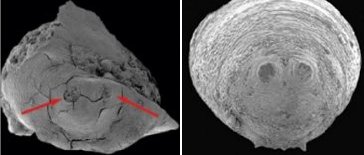Fossil fly from Antarctica
A tiny fly fossil has turned up about 500 kilometers from the South Pole.
By Emily Sohn
Even if you hate winter, there is at least one nice thing about cold weather and snow: no bugs. Or so you thought.
A tiny fly fossil has turned up in Antarctica, about 500 kilometers from the South Pole. Scientists previously thought that the icy continent was never home to this type of fly, which is distantly related to the houseflies living today.
 |
|
A fossil pupa fragment (left) found in Antarctica has a pair of spiracles, or breathing holes (arrows), which marks its species as similar to modern blowflies (pupa, right).
|
| NDSU Electron Microscope Laboratory |
So, two researchers were surprised to find evidence of the ancient fly species in a chunk of siltstone along Antarctica’s Beardmore glacier. The stone also included fossils of tiny marine creatures, algae, mosses, wood, leaves, freshwater mollusks, fish, and several kinds of insects. All of them lived between 3 million and 17 million years ago, the scientists reported.
The fly fossil was part of a shell that protects a larva as it grows into an adult, which means that there were probably many flies living and breeding in Antarctica at the time.
How the flies got to the chilly continent is another question. Antarctica lies thousands of miles from South America, the closest landmass. One theory is that these types of flies flew south when sea levels were lower and the distance was shorter. Another idea is that flies evolved much earlier than previously thought. Antarctica was actually connected to Australia and South America 80 million years ago.
If you’re a bug-hater, one message is clear: Always carry a flyswatter. There’s no safe place!—E. Sohn
Going Deeper:
Perkins, Sid. 2003. Winging south: Finally, a fly fossil from Antarctica. Science News 163(May 10):292. Available at http://www.sciencenews.org/20030510/fob3.asp .







